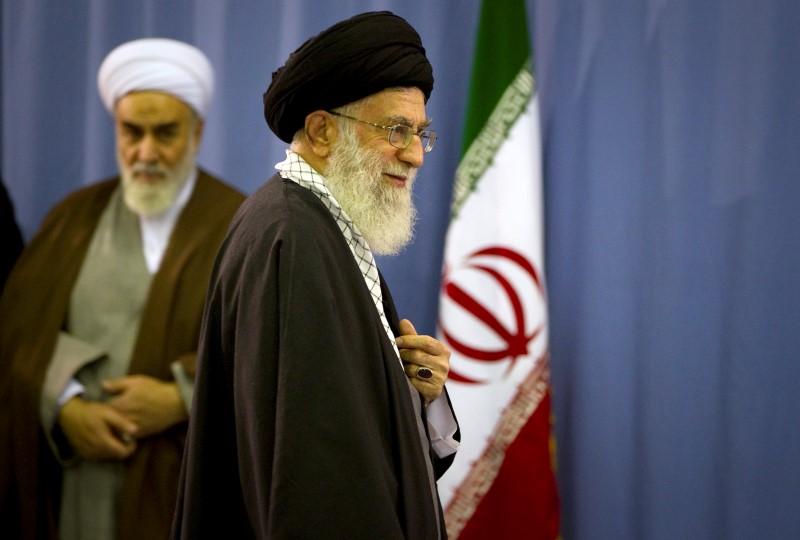Iran’s despot ayatollah pushing for greater power

As the most powerful official in the Islamic Republic, Iran’s Supreme Leader Ali Khamenei is not only considered the ultimate political figure, but also the religious authority.
Khamenei owes his position to the late founder of the regime, Ayatollah Ruhollah Khomeini, who introduced a revolutionary notion in Shiite thought with the concept of Velayat-e Faqih (Guardianship of the Islamic Jurist). This became the basis of the constitution of the Islamic Republic and gave the Vali-ye faqih (Guardian Jurist) custodianship over the people.
When Khamenei succeeded Khomeini with the assistanceof the late Akbar Hashemi Rafsanjani, who was one of the founding fathers of the Islamic Republic, almost 30 years ago, he was not initially considered among the most-qualifiedcandidates, certainly not when compared to powerful religious men such as Ayatollah Hussein-Ali Montazeri, who was the designated successor.
Early on, his religious and political authority was questioned by the high-level clerics in the city of Qom. Khamenei was not a Marja’ or Mujtahed capable of issuing fatwas. He was also considered a weak supreme leader who lacked charisma when compared to Khomeini.
But Khomeini’s inner circle, particularly Rafsanjani, most likely believed that, if Khamenei became the leader, he would serveas a ceremonial figurehead, giving the gilded circle more power to rule. Although Iran’s constitution emphasized the religious authority and qualification of a supreme leader, Khamenei’s appointment was clearly a political move rather than a religious one.
Khamenei did grant significant power to people such as Rafsanjani at the beginning of his rule, but he soon surprised the theocratic establishment by managingto marginalize the high-level clerics who opposed him, creating his own inner circle and foreign policy office, and weakening the position and power of the presidential office. Khamenei also declined to merge the Islamic Revolutionary Guard Corps (IRGC) into the nation’s regular army and he made a robust alliance with the IRGC in order to control those who oppose him.
Since the widespread protests that occurred in 2009, Khamenei has been granting considerable power to the IRGC and the paramilitary group the Basij. He has made the IRGC the backbone of the clerical establishment, as it controls significant sections of Iran’s economic and ideological centers. The senior cadres of the IRGC enjoy the final say in some of Tehran’s foreign policy and its support for proxies.
The Washington office of the opposition group the National Council of Resistance of Iran (NCRI) in 2017 released a 175-page bookentitled “The Rise of Iran’s Revolutionary Guards’ Financial Empire,” in which it demonstrated that the IRGCcontrols more than half of Iran’s gross domestic product and owns several major economic powerhouses and religious endowments, such as Astan-e Qods Razavi in the northeastern city of Mashhad. And, in June, the NCRI published another book on 15 terrorist training centers in Iran, where the IRGCprovides ideological, military and tactical training to foreign recruits, who are later dispatched to countries in the Middle East and beyond to conduct terrorist activities.
Another tool Khamenei has been using to crush any opposition to his decisions is accumulating wealth by grantingtax exemptions to his “religious” organizations. For example, one of Khamenei’s major organizations, which is rarely spoken of, is known as Setad. It is worthat least $95 billion. Roughly half of its holdings are in the corporate field and the other half in real estate, mainly through “the systematicseizure of thousands of properties belonging to ordinary Iranians,” mostly dissidents and foreign expatriates, according to Reuters.
Khamenei’s organizations enjoy the advantage of monopolizing economic sectors, allowing them to exploit the nation’s wealth while bending the law in order to maximize profits. This financial empire is giving Khamenei critical economic and political leverage over the regime’s apparatuses, politicians and opposition. It is also allowing him to expand his circle of hard-line loyalists and foreign proxies, and easily crush dissidents by exploiting the nation’s wealth.
Khamenei surprised the theocratic establishment by managing to marginalize the high-level clerics who opposed him.
Dr. Majid Rafizadeh
The latest moves by Khamenei show that he is attempting to further tighten his grip on power by ignoring his own government’s constitution and stifling the few democratic elements left in the nation. For example, the Iranian Parliament, which is the nation’s legislature, was not involved in this month’s decision to hike gas prices — a move that provoked widespread unrest.
Also, in 2018, Khamenei set up a committee, labeled the economic war room, which consists of two hard-liners and one so-called moderate — the heads of the three branches of government, President Hassan Rouhani, Parliament Speaker Ali Larijani and Judiciary Chief Ebrahim Raisi. The committee essentially grants the supreme leader the power to enact any law he desires by skirting Parliament and Iran’s lawmakers.
Khamenei has made Iran a country ruled by one man; and the despot ayatollah is pushing to further tighten his grip on power.
- Dr. Majid Rafizadeh is a Harvard-educated Iranian-American political scientist. He is a leading expert on Iran and US foreign policy, a businessman and president of the International American Council. Twitter: @Dr_Rafizadeh









































